* Important note: This is a review of the original version with all stainless steel gearing. Tica has changed the design and now the pinions are "brass" in 8000 size and other alloys in smaller sizes. Use this review only as a reference for an old version.
--------------------------------------------------------------------------------------------------------------------------------------------------------
Tica Talisman TG8000 : The Review
Hello all
This review has been a top request by readers from South East Asia and Australia, who over the past 10-12 months have sent me more than a few emails asking about this specific reel. Naturally the Talisman caught my attention when specifications started appearing on the web around Christmas 2010, but the huge interest from those regions made me bring it to the top of my list, and here we are.
 The Talisman is basically another reel trying to present itself as a low cost alternative to the super-spinners. "Super-spinners" is a term I invented a few years ago to describe a group of elite spinning reels that are made to handle extremely heavy duty work and bring in fish that in the past were considered too big and too powerful for any spinning reel. There are four true super-spinners in the world today: Shimano Stella, Daiwa Saltiga, Accurate TwinSpin, and recently Penn Torque Spinning officially joined the club after they updated them and solved the bail bending and a couple of other issues that I highlighted in my review earlier. So far efforts to create a low cost alternatives to those super-spinners failed quite miserably, with the exception of Omoto's Severo which is a very good copy of the Accuarate TwinSpin that works, but Omoto is doing a poor job marketing them leading to their virtual inexistence on the waters of the world. In today's review we will examine Tica's effort at creating another alternative, and see if they have succeeded or not.
The Talisman TG8000 replaces the discontinued Taurus as the flagship reel of Tica's products. The defunct Taurus was a very good reel on paper, but because of several factors, mainly the quality of materials and components, the Taurus never rose to the expectations or took off as a serious heavy duty reel. As I proceed I will draw comparisons to the Taurus, and references to the 4 super-spinners will be inevitable too.
The TG8000 comes in two retrieve speeds: 4.3:1 for jigging and bottom fishing, and 5.2:1 for topwater poppoing. The reel in this review is the slow model. They advertise the weight as 700 grams, and in a rare occurrence that figure is indeed true. Actually mine weighed exactly 696 grams or 24.5 oz without line. The spool took 270m (~295 yds) of PE6 (0.40 mm) line.
Few pics, particularly showing the cosmetic carbon fibre inserts in the spool
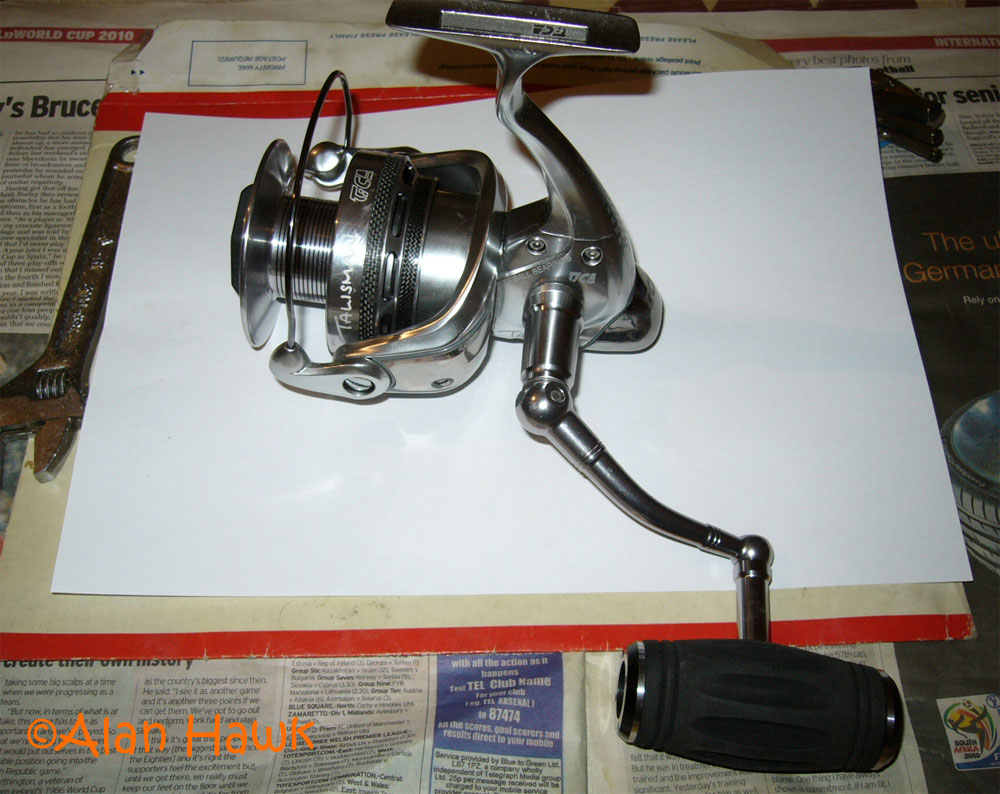  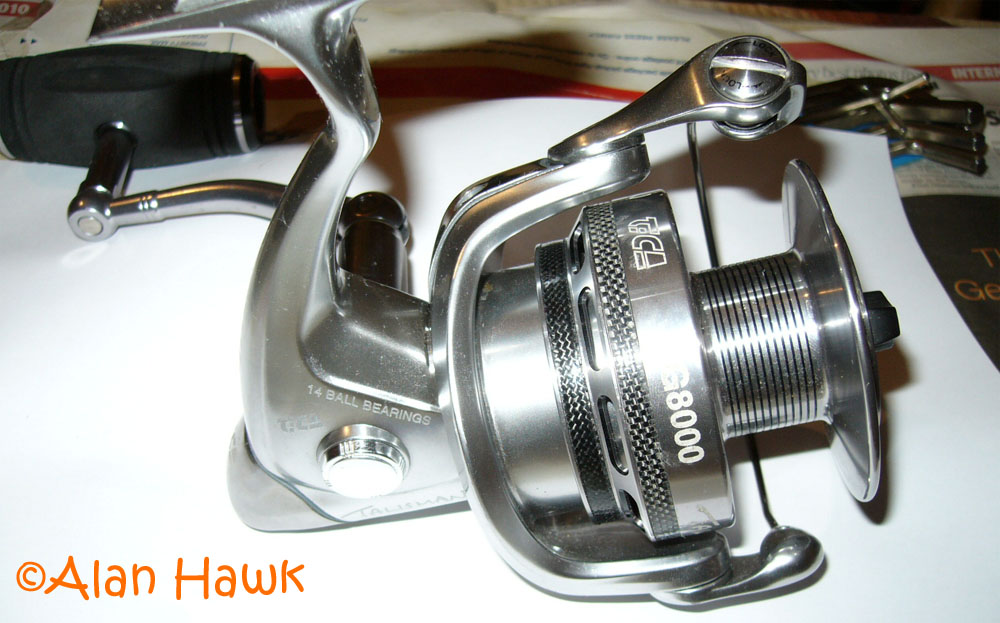  The reel's foot has a unique serial number
 And the same serial number is stuck on the reel's manual
 That serial number stuff is pretty useless indeed, but it goes to show the special treatment they give to their top of the line reel. The manual is pretty fun to read because of the dodgy English used in it. For example it says "Do not put your fingers in between handle and reel body" which if you think about it makes it pretty impossible to grab the handle and operate the reel! It also says "Do not reel in other-than fishing activities" which is even more puzzling as I can't think of any other "activity" in which you could use it to "reel in" things, except maybe if you lived in an apartment block and wanted to steal the underwear that your sexy neighbour left out in the balcony to dry!
 What comes with it
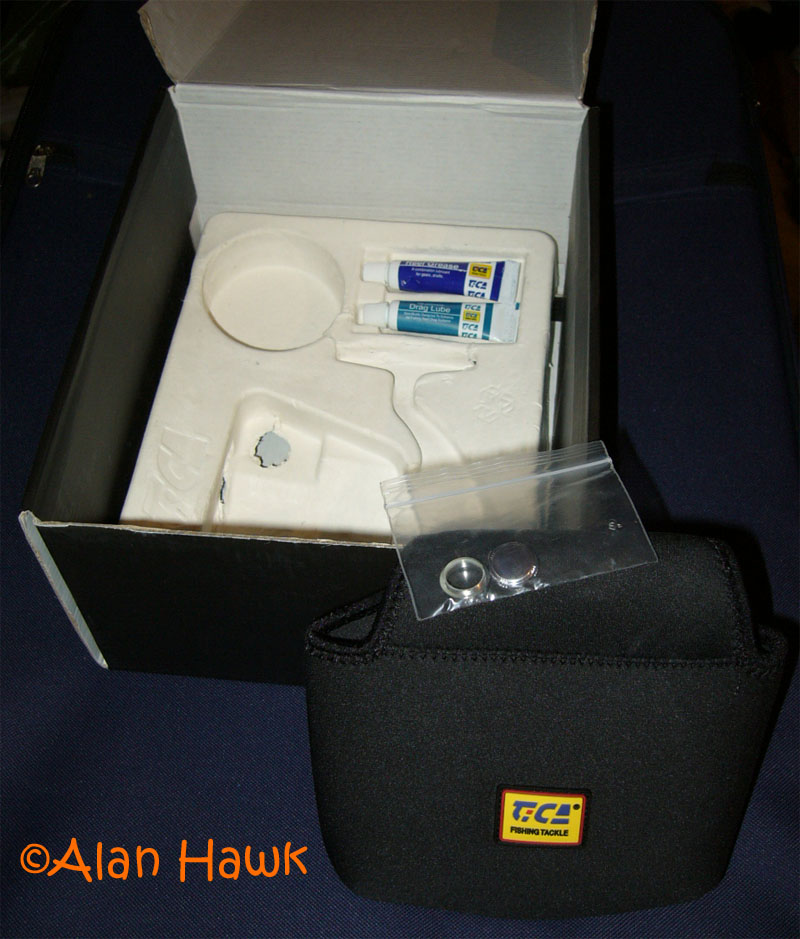 It comes in a needlessly oversized box, with a manual, a reel bag, two tubes of oil and grease, and a little plastic bag containing two spare side caps, spool shims, and an Allen key (the shims and the key are not pictured). As you can see there is a special recess for an extra spool inside the box, and that extra spool might come or not depending on the price. Speaking of the price, the Talisman TG8000 is being offered at all sorts of arbitrary prices from $190 to $400. I ordered mine from China without a spare spool for $190 excluding shipping, and it could be bought on ebay for around $250 (with a spare spool) if you look carefully.
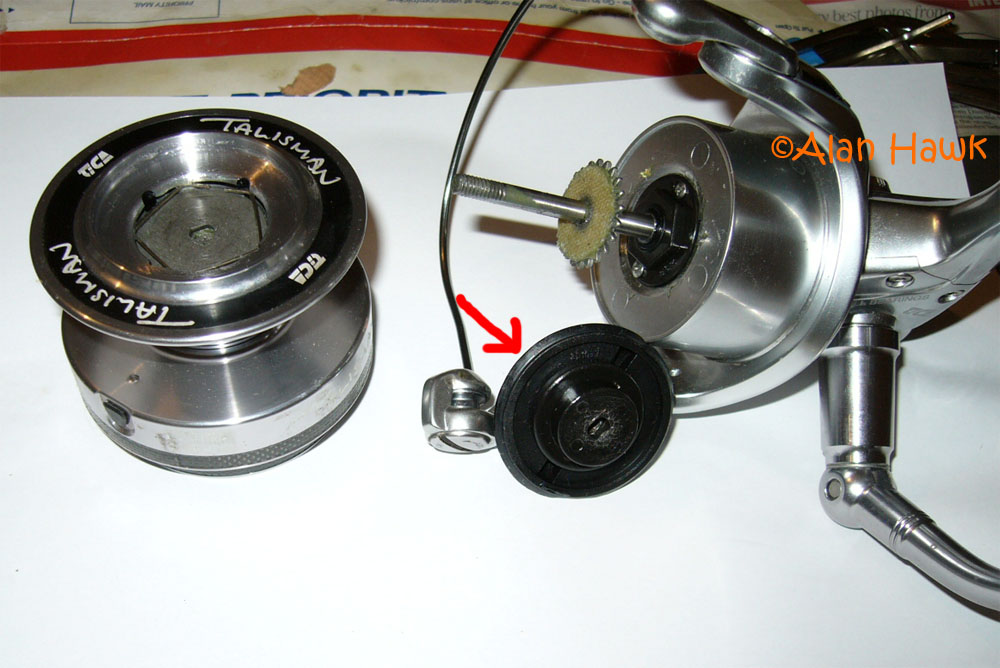 The reel is supposed to have a waterproof drag. The drag knob does indeed have a rubber seal around its lip (red arrow in the photo above), but let's just call it a "theoretical" seal....
 ... because in reality the seal is slightly undersized, leaving a 1 mm gap between the seal and the spool on the entire perimeter. I put a piece of paper in that gap to demonstrate. That undersized seal will provide a great deal of protection against water splashes on a moving boat, but it doesn't qualify as a "waterproof" drag by any means.
The drag
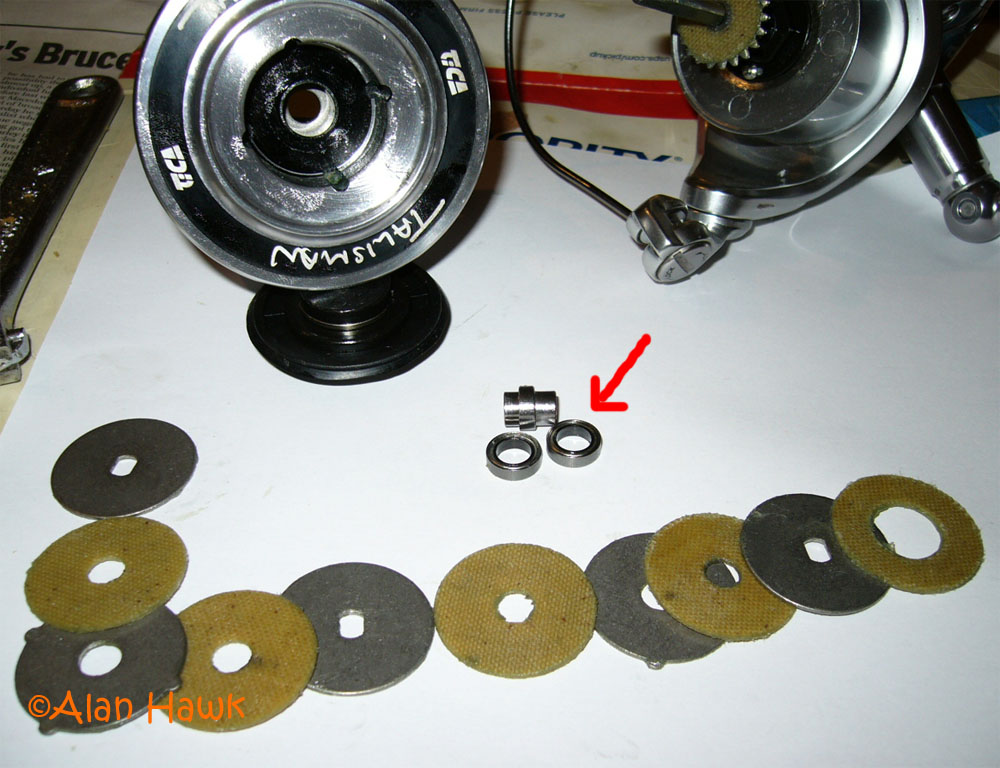 The spool spins on two ball bearings. The red arrow points to those bearings and the hub they are mounted on. The drag stack is composed of 5 woven washers and 5 metal pressure discs. The drag is sticky, pure and simple. That means that there is a noticeable jerk when the spool starts giving line at the beginning of a fight. Cleaning the washers and lubing them helped to a degree and made the reel fishable, but I believe that upgrading the drag with carbon fibre washers would benefit the reel greatly.
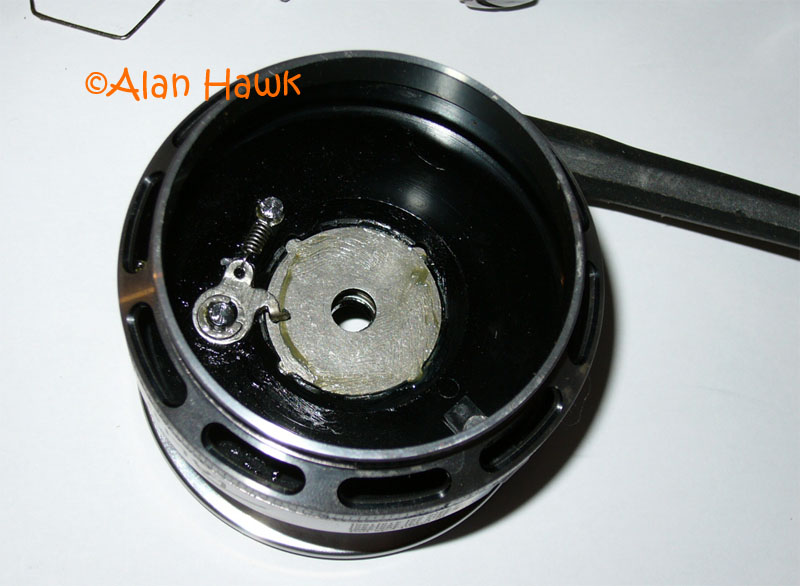 The photo above shows the backside of the spool. There is a tough black finish to prevent corrosion in that hidden area, and the clicker is of a simple and durable design. Also seen is the metal disc that works as a secondary part of the drag system.
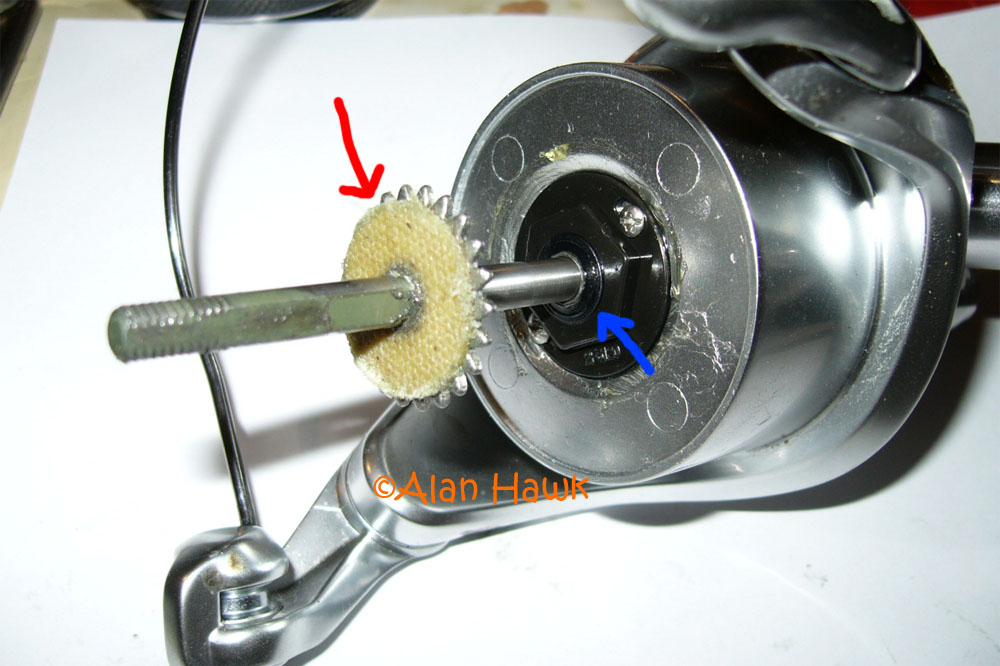 The red arrow in the above photo points to the woven washer that presses against the metal disc shown in the previous photo, creating a secondary drag system underneath the spool. That washer also functions as a spool shim as you can add one or two of the extra washers that come with it to change the line lay on the spool. The blue arrow points to the seal of the main shaft which keeps water from entering the reel's body.
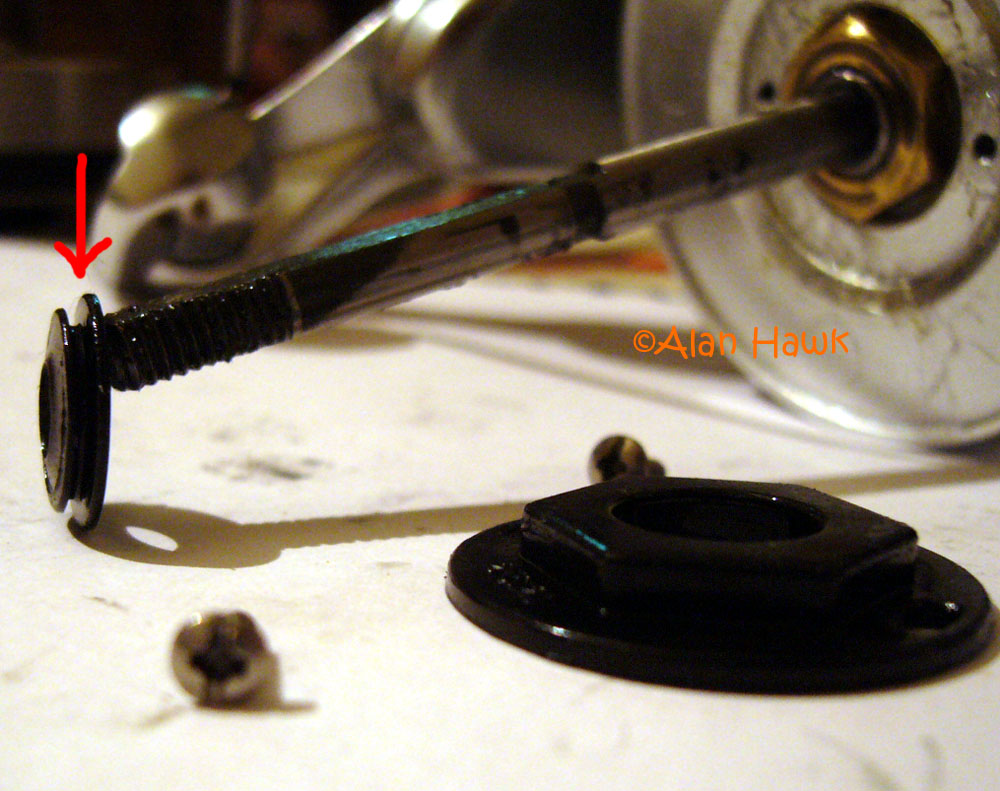 A closeup on that seal. Sturdy and effective.
Taking the rotor off
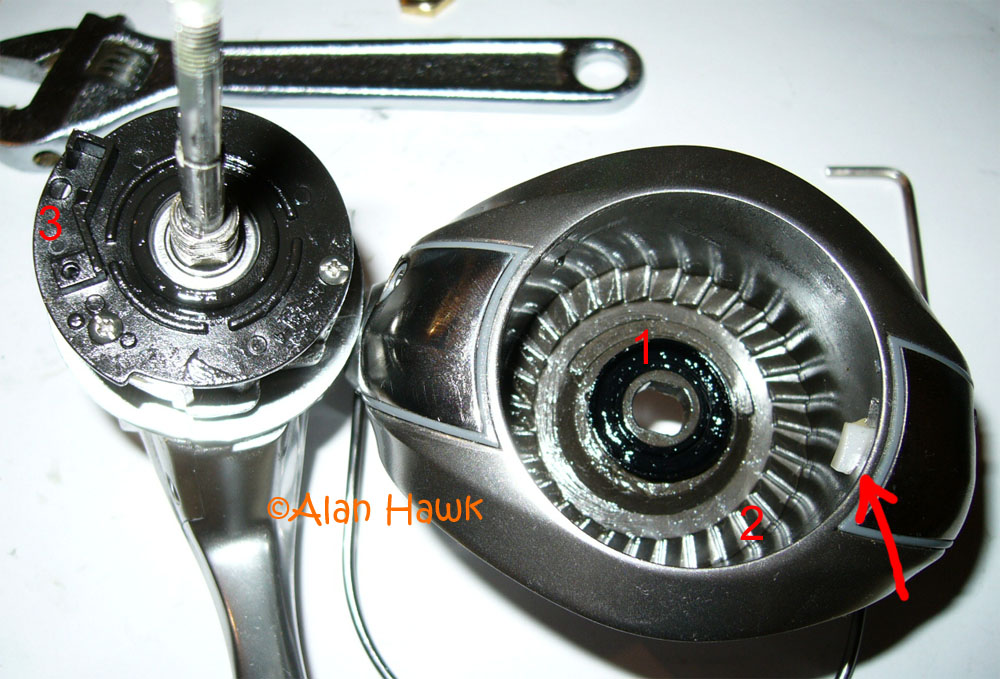 The backside of the rotor has another seal (#1) to prevent water from getting into the pinion assembly. You can see that teeth were cast into the rotor (#2) to create a backup mechanical stop in case the anti-reverse clutch fails, but they abandoned that backup and left the teeth unused. #3 is the area where the ratchet for the mechanical stop was supposed to be installed, also left unused. The red arrow points the rotor brake lever. This small lever moves downwards when the bail is opened and comes in contact with the reel housing's flange to keep the rotor from moving while a cast is being made, but it does not work at all. The material used is too stiff and slippery to create any friction, hence there is no braking what so ever and the rotor is free to spin with the bail opened. This is not a major problem though because the reel does not have an auto bail trip, meaning that you have to close the bail manually, so the spinning of the rotor during a cast will not cause a premature bail closure.
Going further in
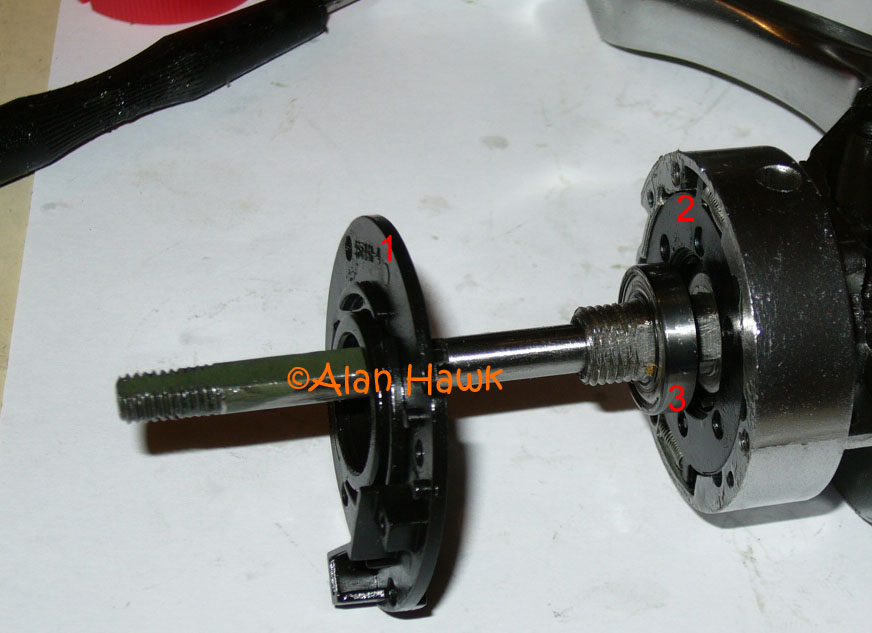 The anti-reverse clutch retainer (#1) removed, and you can see the clutch itself (#2), and a mysterious ball bearing (#3). That ball bearing is not one of the pinion bearings. There are two other bearings for the pinion further inside. A few people have been making all sorts of guesses, but none came close to the reality of it. Well, I said earlier that the defunct Taurus was a brilliant reel on paper, and the Talisman is no different. This bearing is one of the reasons why I believe that: (Skip the next paragraph if you are not mechanically inclined)
 The left part of the drawing above shows the arrangement of the pinion/clutch assembly in Stella SW and 2010 Saltiga. The pinions of those reels are suspended on two ball bearings, then the anti-reverse clutch is placed in front of them. In that arrangement when the reel is under load, the shaft transfers that load to the pinion, causing the clutch sleeve to move sideways inside of the clutch, therefore creating more friction on some of the braking cylinders and causing more wear to them. Of course we are talking about a minute effect that wouldn't tangibly reduce the life span of a clutch, but it's there nevertheless. In the middle part of the drawing you can see how that extra bearing in the TG8000 eliminates that, being a first line of defence preventing shaft loads from reaching the clutch. The right part of the drawing shows the different arrangement of Accurate TwinSpin and Penn Torque. There are two ball bearings only, and the clutch is safely placed between them protected by the outer bearing. But in this arrangement the clutch's diameter has to be equal to or smaller than the diameter of the outer ball bearing of the pinion in order to fit behind it. Therefore in the Talisman they could use a massive clutch yet eliminate the excess friction in the clutch by using that third bearing. Well made clutches will function reliably regardless of their diameter, but big clutches can accommodate individual leaf and coiled springs which make the rotation lighter and increase longevity.
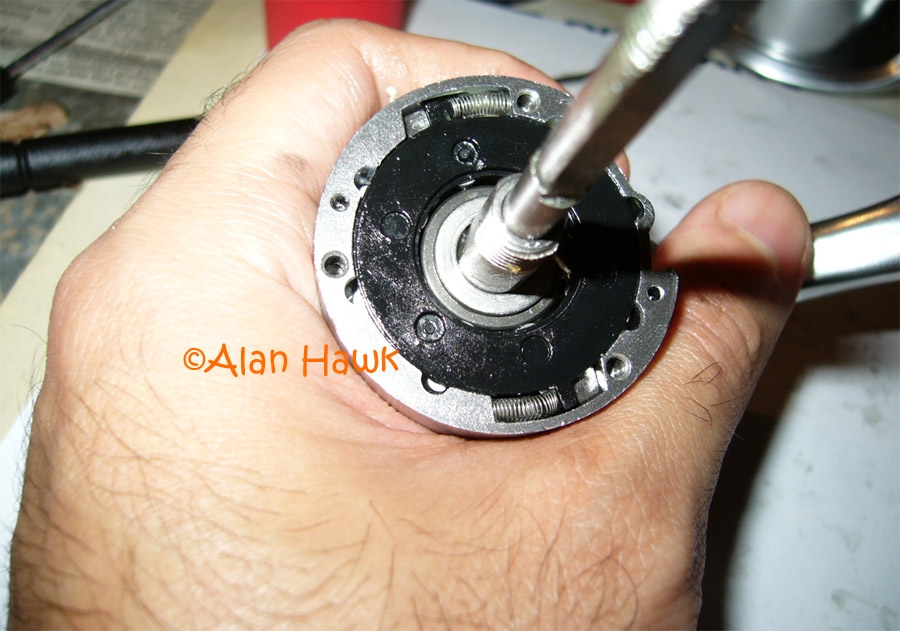 In the TG8000 they used two main coil springs for the outer cage instead of using one for each cylinder. The lock is solid without any back play.
The clutch unit out
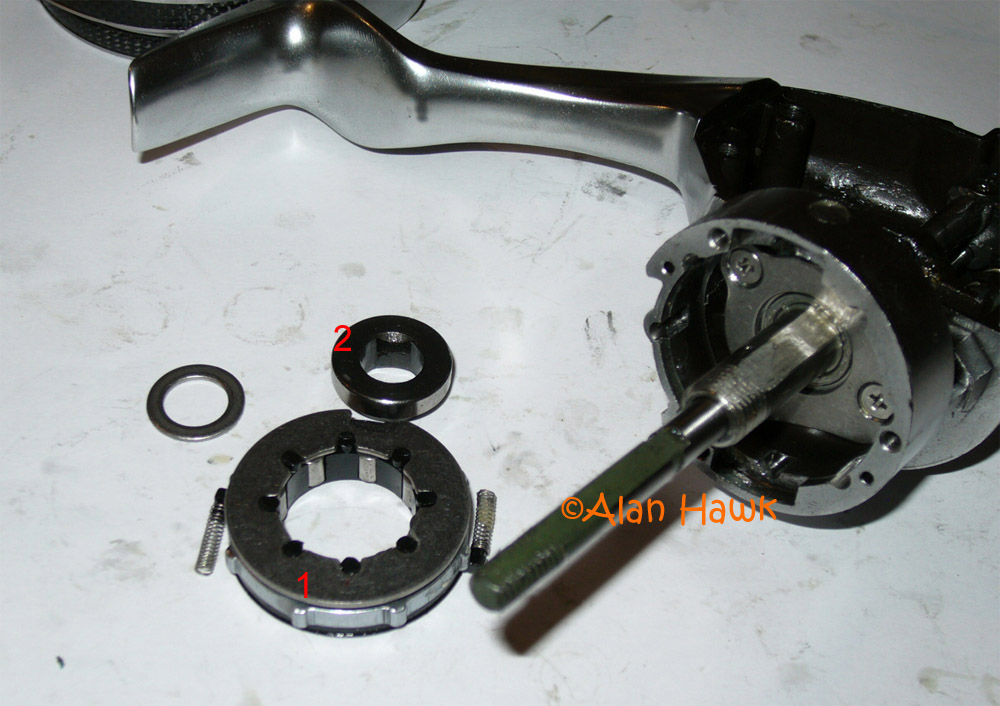 The clutch unit (#1) can't be disassembled. To clean it spray it and the clutch sleeve (#2) thoroughly with a solvent such as WD40, then shake well and leave to dry before applying light synthetic oil to each of the brake cylinders and the sleeve.
A closer look
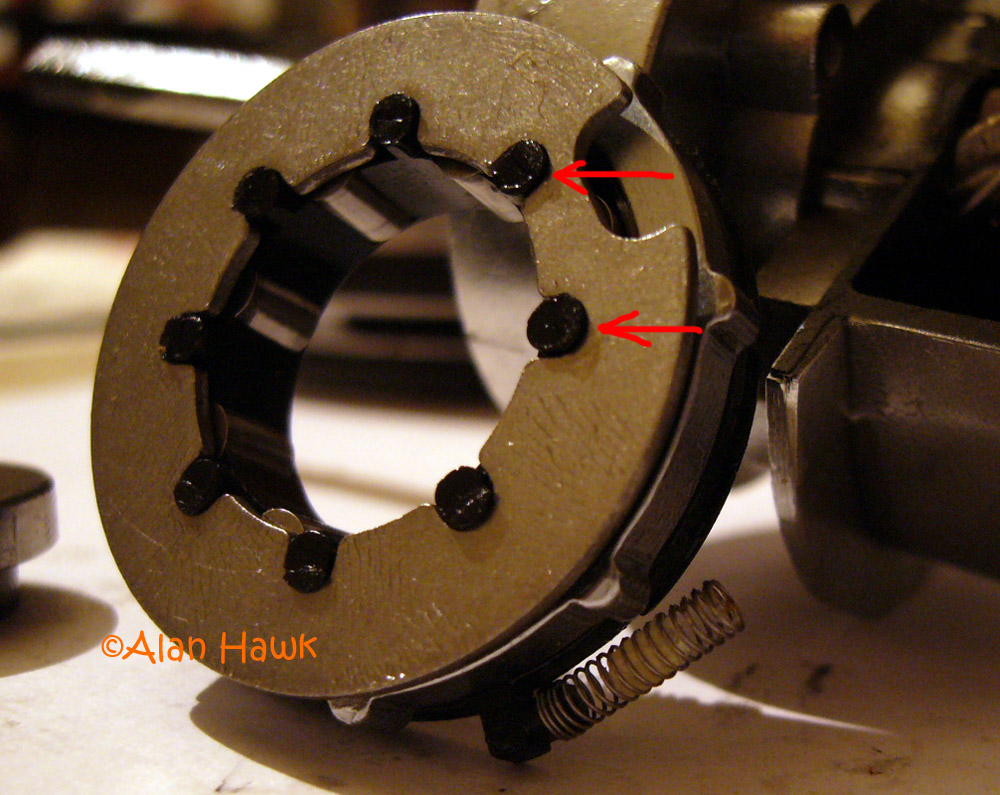 This is why it can't be disassembled: It was put together, then the tips of the plastic posts (red arrows) were ironed down to create caps. Very cheap and very crude, but it does the job.
Getting inside the gearbox
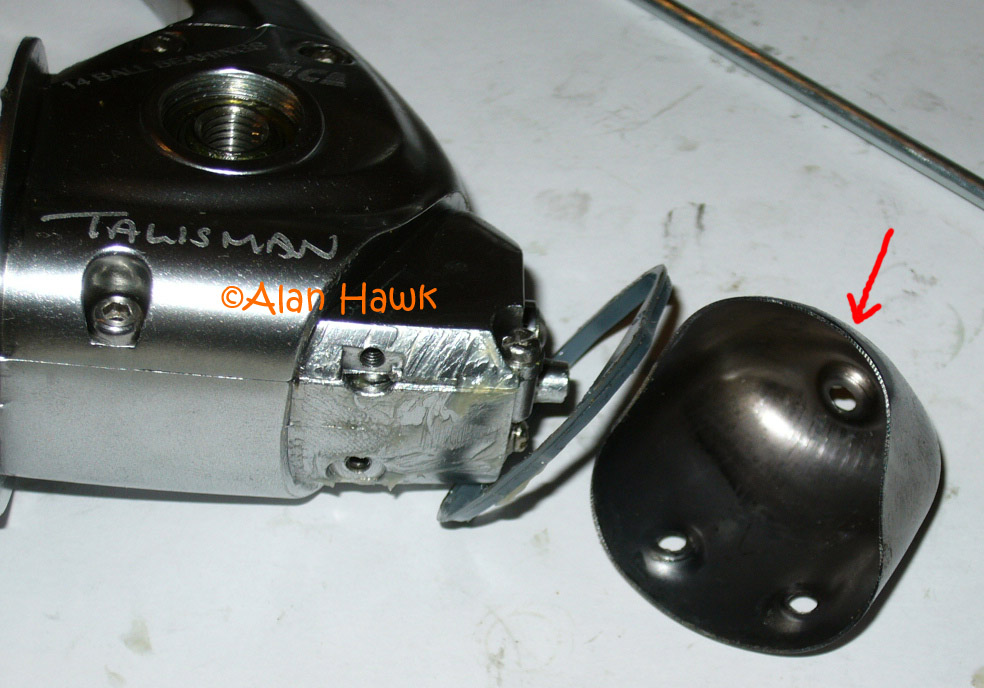 The rear shield (red arrow) is not plastic, it's made of stainless steel. There is no seal to keep water from getting in as in the 2010 Saltiga, and there are no drainage holes to allow water to get out as in Stella SW. So corrosion will occur eventually in the area behind that shield. Corrosion in that area was a common problem with 2001 Stella (FA) that was corrected with the addition of 2 drainage holes in the rear shield of 2008 Stella (SW). This is why in the photo above you can see that they covered that hidden area with a heavy layer of grease at the factory.
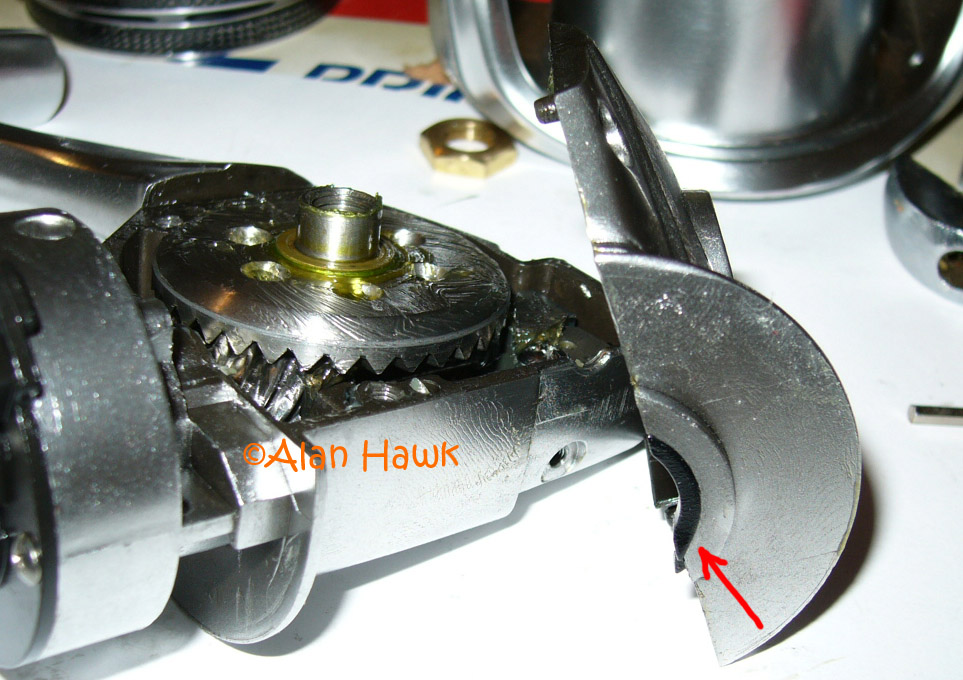 The side cover has a small rubber flange seal (red arrow). We'll talk more about waterproofing later.
Internals
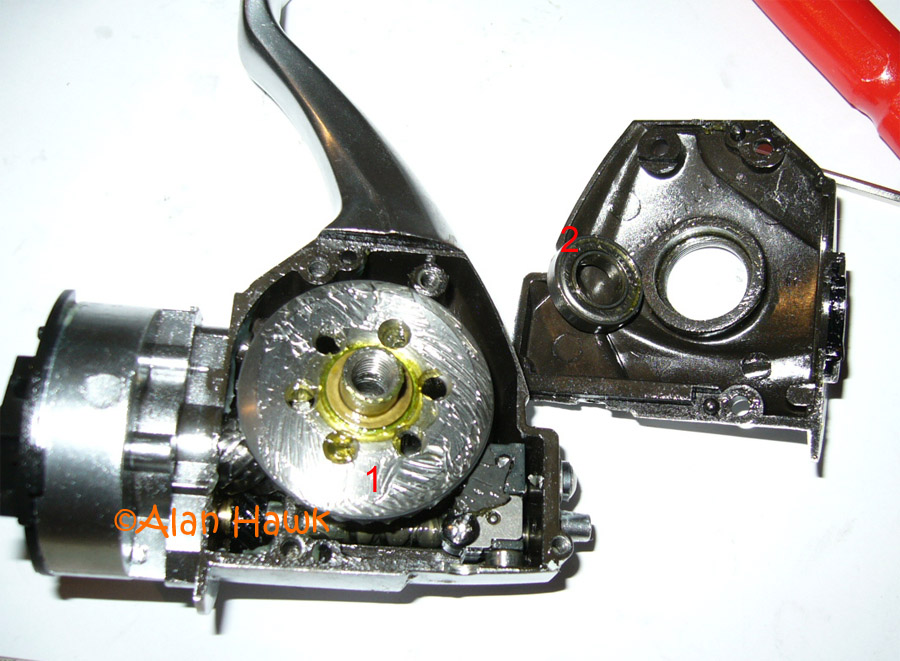 #1 is the stainless steel drive gear, and #2 is one of the two ball bearings the drive gear is mounted on. The reel has 14 ball bearings, all of them are of the new corrosion-resistant type.
Drive gear
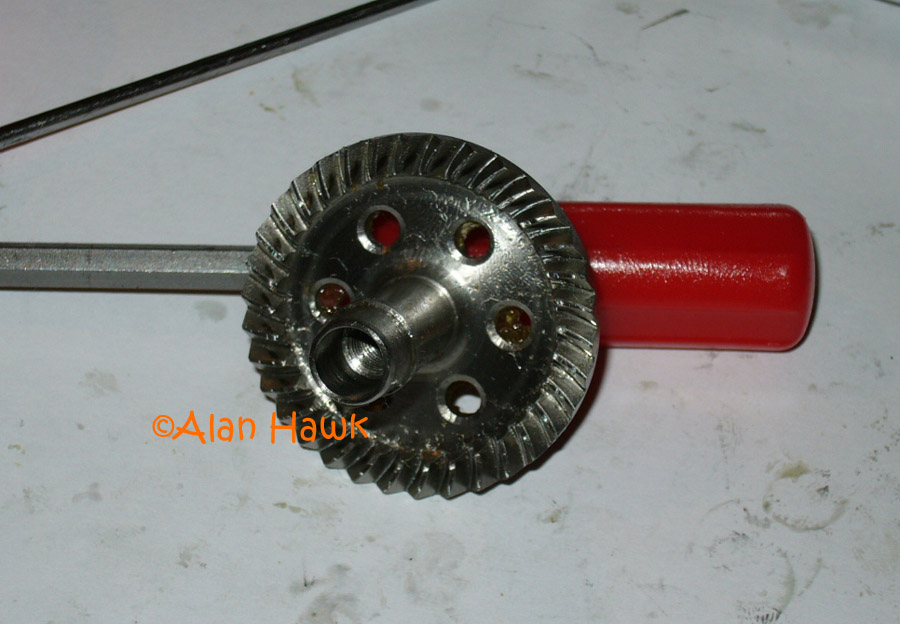 The previous flagship reel of Tica, the Taurus, had a brass drive gear. It was relatively durable but lacked in strength. People who used the Taurus for heavy work reported breakages in the gears. For the Talisman they opted for a machined stainless steel drive gear instead, but that does not automatically mean strength because all stainless steel was not created equal. There are many many different stainless steel alloys and numerous treatment and forming methods, therefore many types of stainless steel would actually perform inferior to a properly made aluminium or bronze alloys. The only way I could know was to test the reel over a period of time this summer and to keep examining the wear pattern, always checking for signs of weakness.
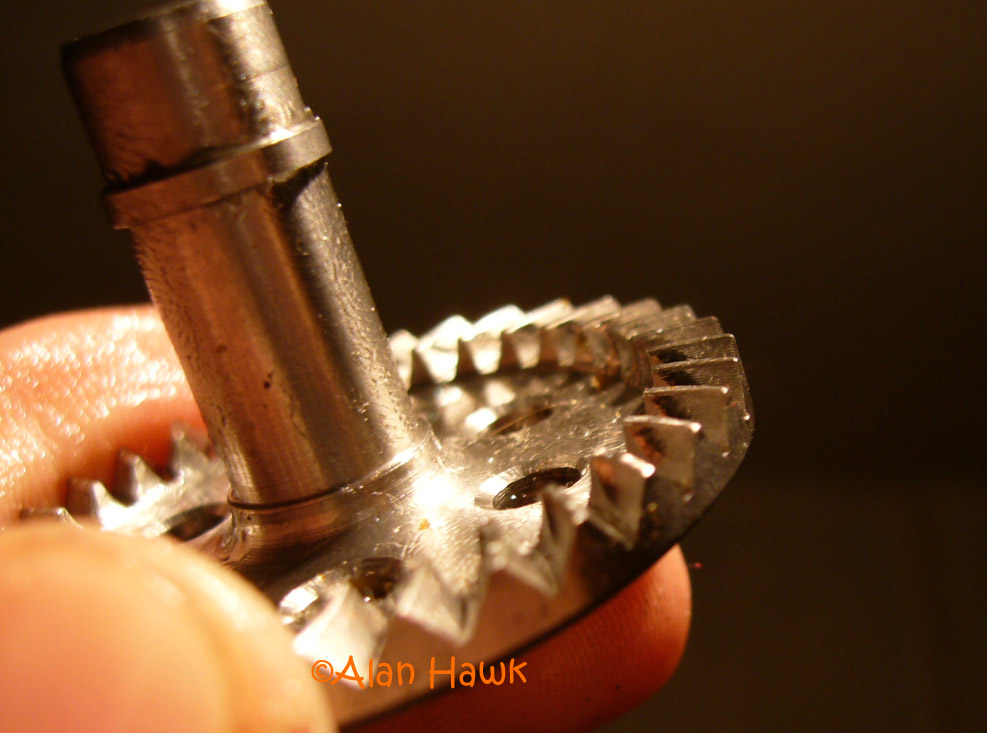 If you look closely at the photo above you will be able to see a shiny area repeated on the left half of each of the teeth. This is the wear caused by nearly 200 hours of active fishing action. Evaluating the wear is not an exact science, but in judging that I rely on my senses and observations from the literally hundreds of reels that I have examined over decades. I would say that relative to the use it saw, the gearing of the TG8000 has a low wear rate, meaning it resists wear considerably well.
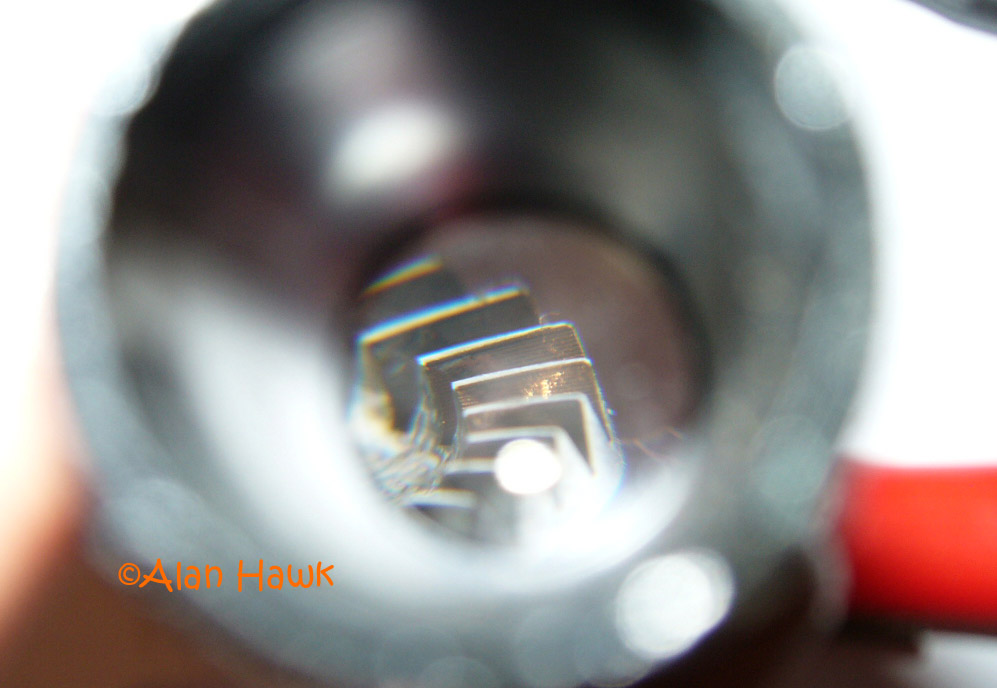 Under a magnifier you can see the horizontal lines on each teeth, and notice how those lines are interrupted by wear on the left half of each tooth. This demonstrates the difference between traditional gear cutting and the new methods used by Daiwa and Shimano to create teeth on both the drive gear and the pinion that mesh perfectly and distribute the load evenly on the entire surface area of each tooth for more strength and less wear. In the Talisman's drive gear a certain part of the tooth (the shiny bit) bears greater load as it pushes on the pinion. On Saltiga's "Digigear" or Stella's "3D Gear" the wear marks are evenly spread on the entire tooth. High end Japanese reels sell for a thousand dollars for a reason.
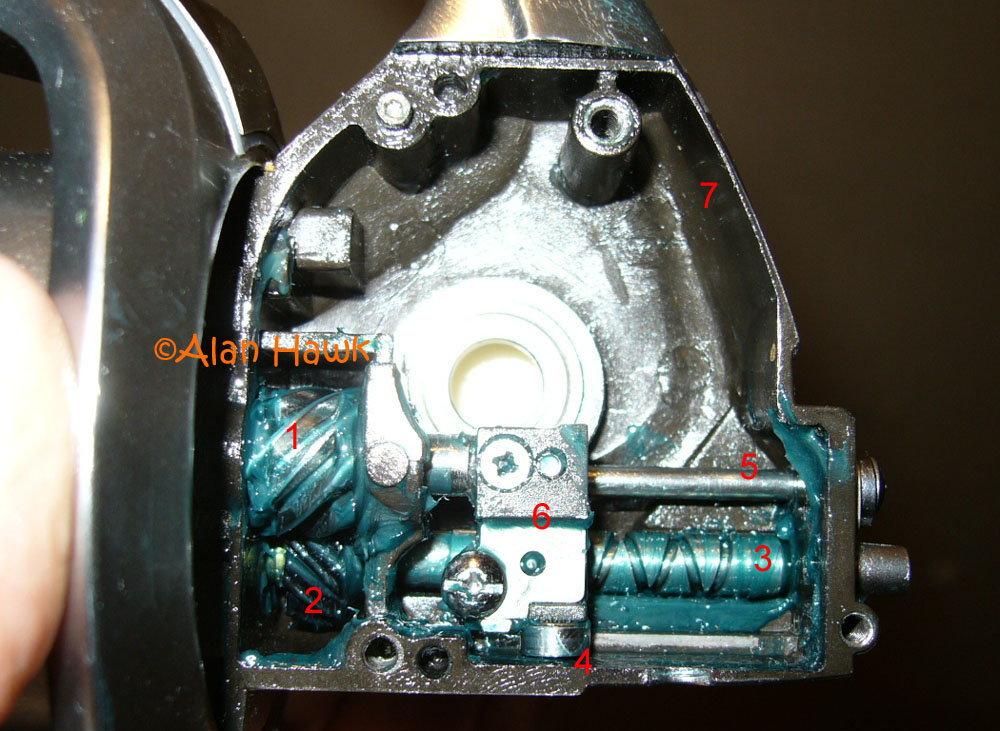 In this crowded photo #1 is the pinion, #2 is the oscillation drive gear, and #3 is the oscillation worm gear. Interestingly the traverse cam (#6) is mounted in what I'd call a "hybrid" style. In the Saltiga the traverse cam runs on two ball bearings, and in the Stella the cam is suspended on two steel rods. Tica took half the arrangement of each: In the above photo you can see that the cam has one steel rod (#5) going through its top, and a ball bearing (#4) on its bottom. Interesting and unique design taken directly from the Taurus. Of course the ball bearing virtually eliminates friction between the cam and the reel's body as you reel in a fish or a heavy lure. The body of the reel (#7) is the exact same body of the old Taurus, but without the holes for the anti-reverse switch which was on the Taurus but not the Talisman.
Proceeding
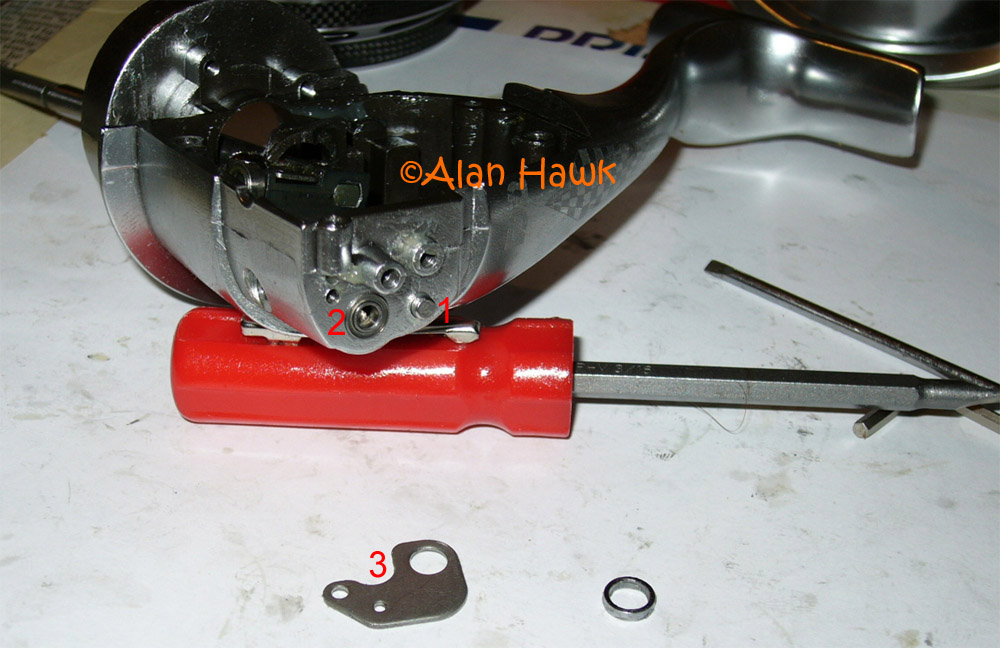 Removing the retaining plate (#3) in order to take out the oscillation system. #2 is one of the two tiny ball bearings the worm gear is mounted on, and #1 is the steel rod discussed in the previous paragraph. In Stella SW there is a seal underneath the retainer to protect the gearbox against water intrusion through the holes for the oscillation mechanism, but there is no such seal in the Talisman. That brings us to a claim made in the specifications that the reel has "waterproofing", whatever that means. There are a few seals here and there, but nowhere near enough to warrant it a "waterproof" status. For example the three screw holes for the rear shield retention go all the way through to the gearbox, yet there is nothing to keep water from getting behind the shield and into those screw holes. Add that to the undersized drag seal and we have a reel that is "splash resistant" at best.
Main shaft
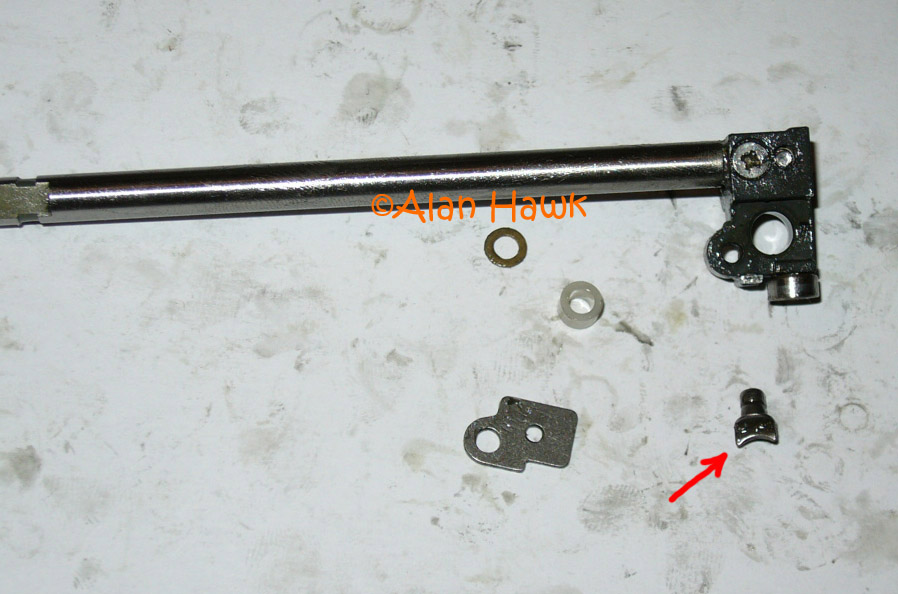 The red arrow points to the most critical component of the oscillation system, the oscillation pawl. Again, the wear rate of that pawl is not bad at all.
The rest of it
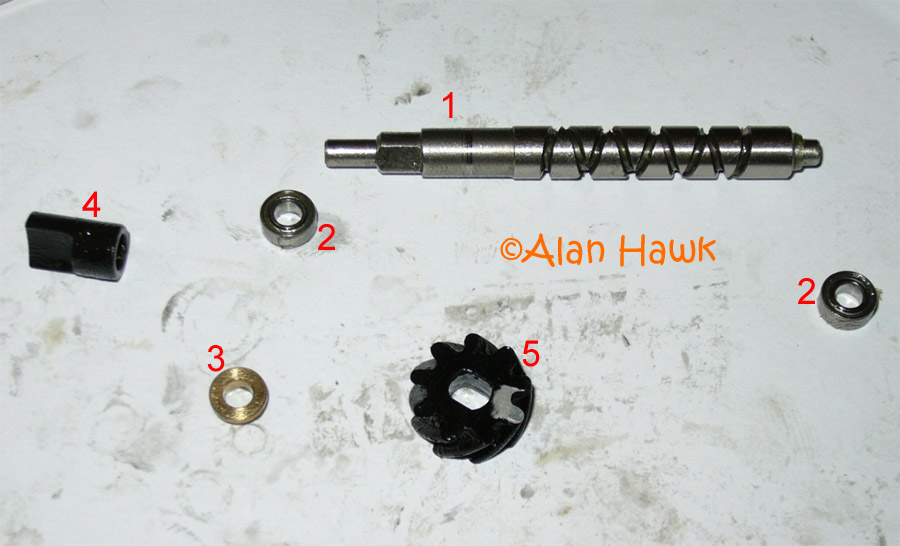 The remainder of the oscillation system. #1 is the worm gear, #2 are the two ball bearings of the worm gear, #3 & #4 are spacers, and #5 is the oscillation drive gear. You can see a spot on that gear that has no finish on it, which is a manufacturing error typical of low cost reels.
Tica went with the worm gear oscillation system for its superior line lay which enhances casting and reduces wind knots. The problems with worm gear oscillation systems in general are their relative complexity, and the fact that they will wear and deteriorate quickly unless they are made to very high standards requiring expensive alloys and tight machining and regulating tolerances. This is why 90% of all spinning reels in the world have a traditional locomotive oscillation system, including 3 out of the 4 super-spinners. For Tica to make a dependable worm gear oscillation and keep the cost low, they opted for a full stainless steel worm gear instead of an advanced alloy. That was a bold move because stainless steel is heavier than you would believe. Look at this:
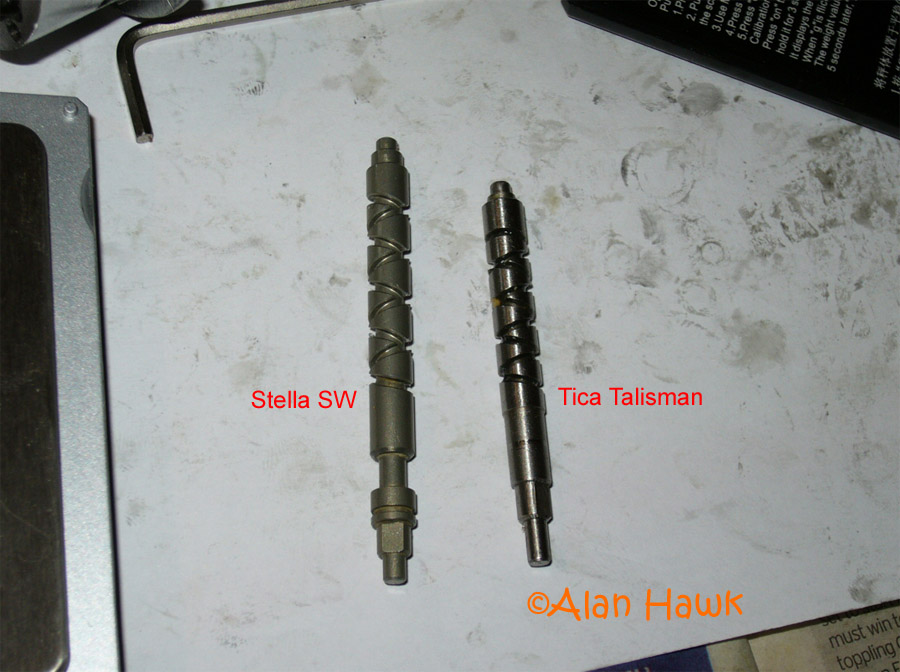 On the left a worm gear of a Stella SW18000 that for some reason I found in my wallet (
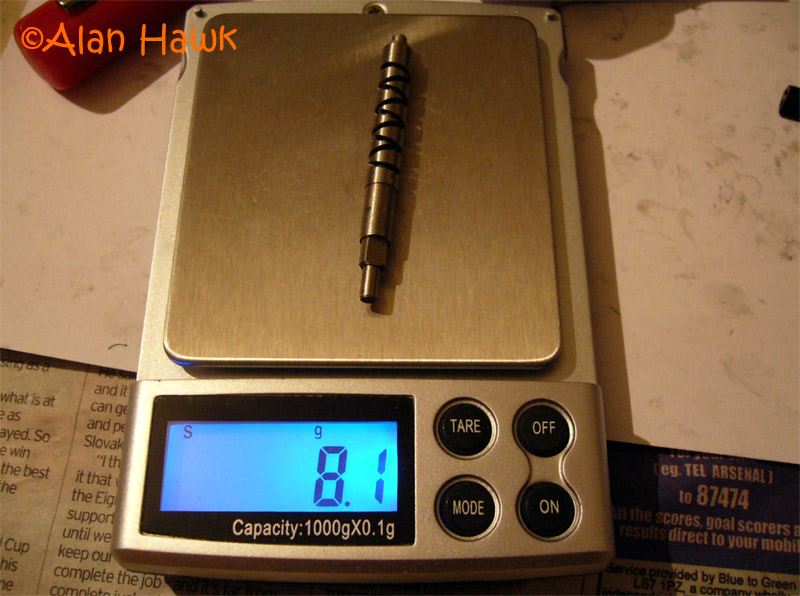 Tica's weighs 8.1 grams....
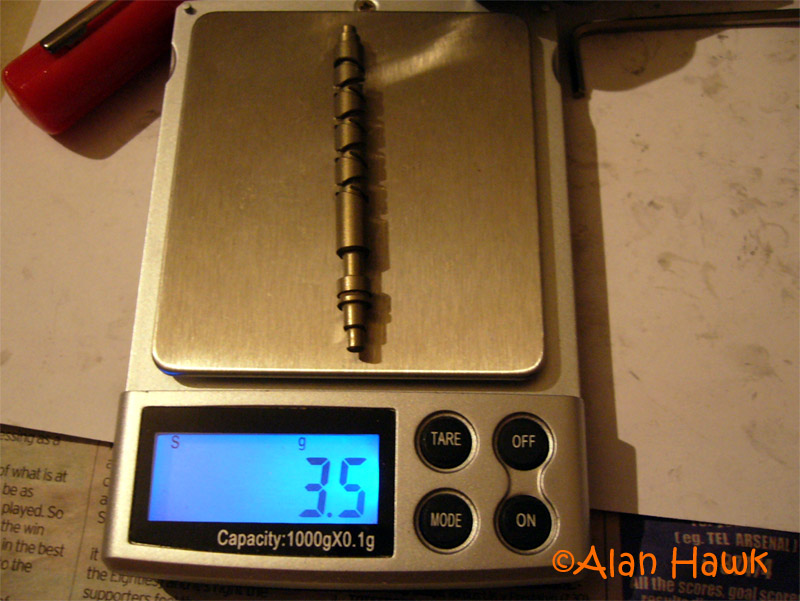 ... and the bigger one of the Stella weighs only 3.5 grams, less than half the weight of the Tica's! By making theirs from stainless steel Tica sacrificed weight in order to achieve the same strength without the use of an expensive lightweight alloy.
The pinion
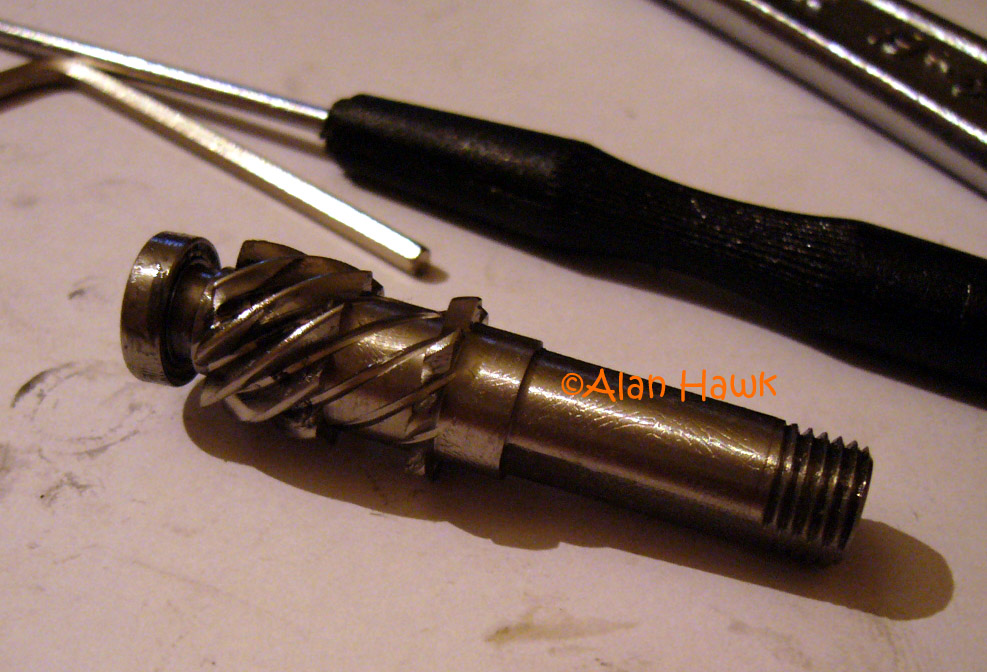 The pinion is machined stainless steel as well, seen in this photo with the little ball bearing that carries it on the inner end. While the pinion of the TG8000 is not as heavy gauge as other reels in its size class, it's doing its job well. All in all, the gearing of the Talisman is strong and reliable. It's not up there with the gearing of the Stellas and Saltigas or the Penn Torque, but I would not hesitate to claim that it's vastly superior to the gearing of the second tier Japanese reels such as Shimano's Twin Power SW and Daiwa Catalina.
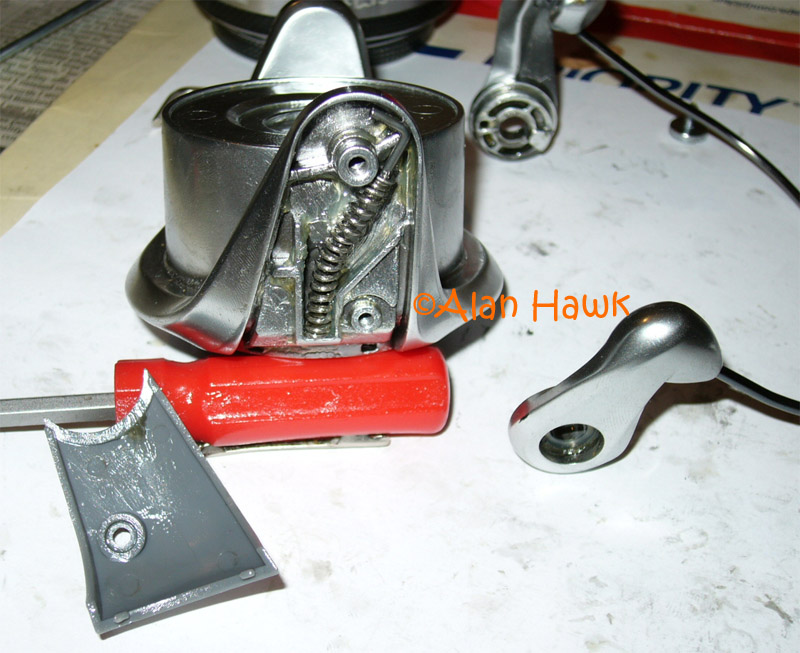 A very ordinary bail mechanism.
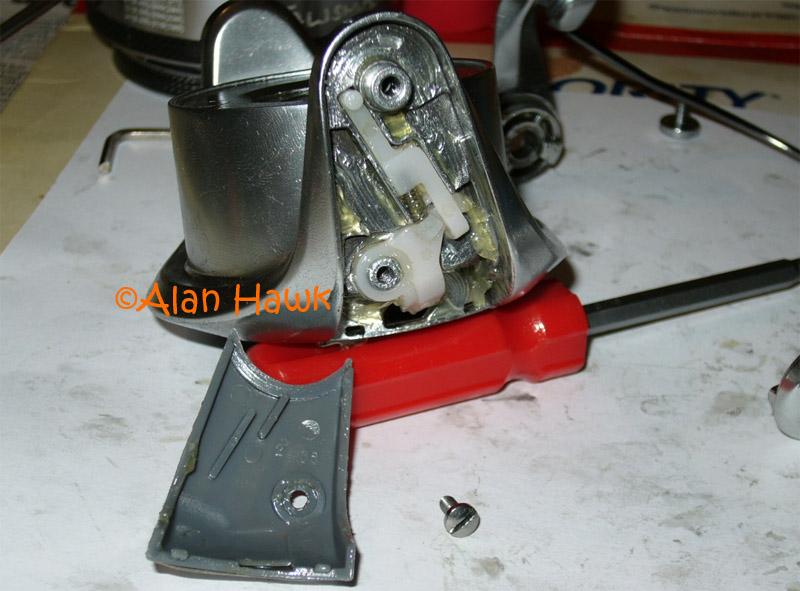 The other side has the rotor brake mechanism. We have already established that the brake doesn't work, so everything here is pretty much useless. I would have thrown these levers away, but that would ruin the balance of the rotor.
The line roller assembly
 Nothing out of ordinary here. Pretty standard and proven design: #1 is the line roller, #2 are the two ball bearings of the roller, #3 are washers, #4 a spacer, and #5 is the screw keeping it all in place.
And I saved the best for last
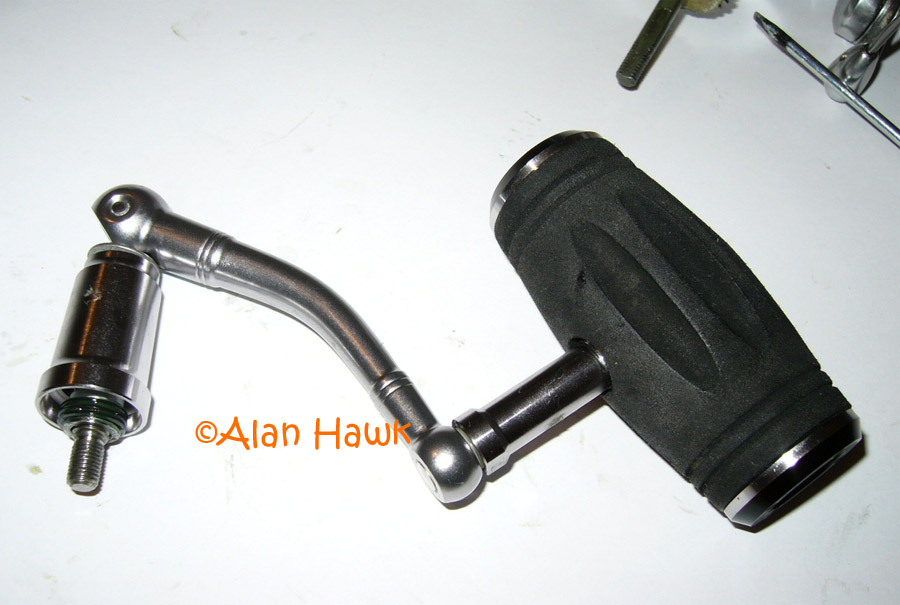 The whole handle is pretty good, but the feel and quality of construction of the grip are particularly brilliant. The grip's material is Dupont's Hypalon which is soft yet doesn't disintegrate with use, and it doesn't slip no matter how wet your hand is.
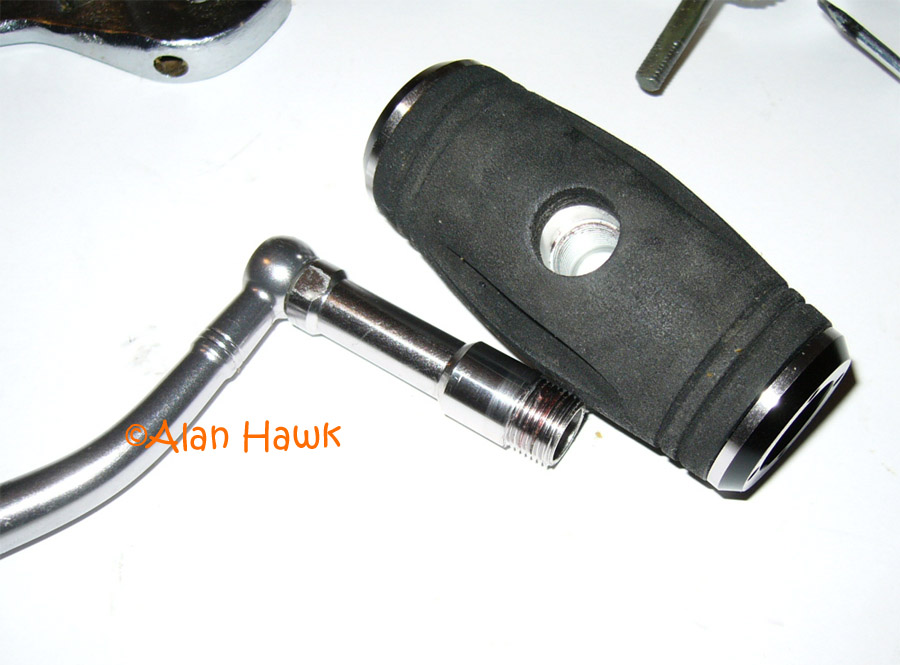 Quite an unorthodox way to disassemble the handle: Hold the shaft still and unscrew the grip.
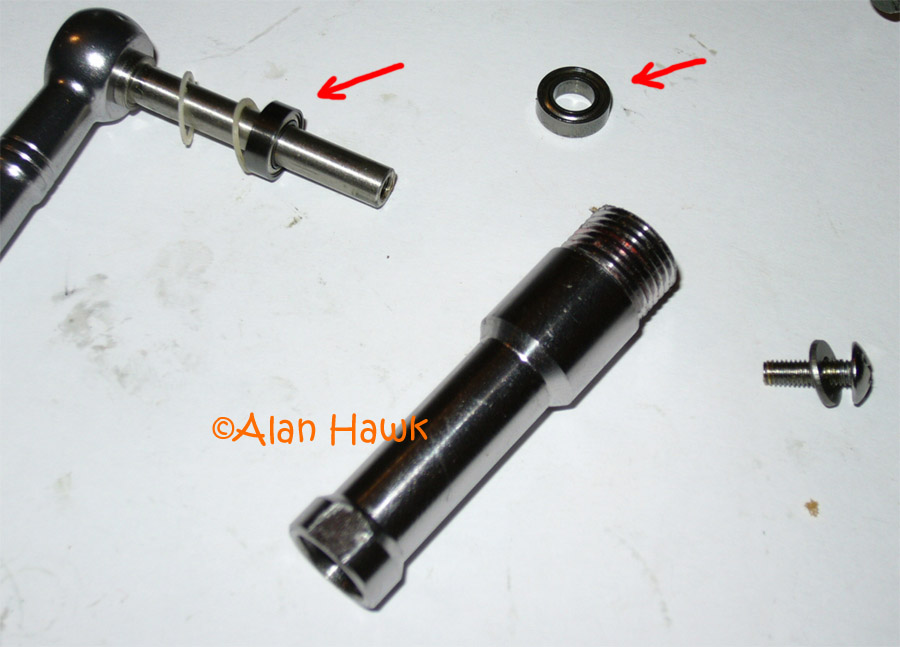 The red arrows point the two ball bearings the grip spins on super smoothly.
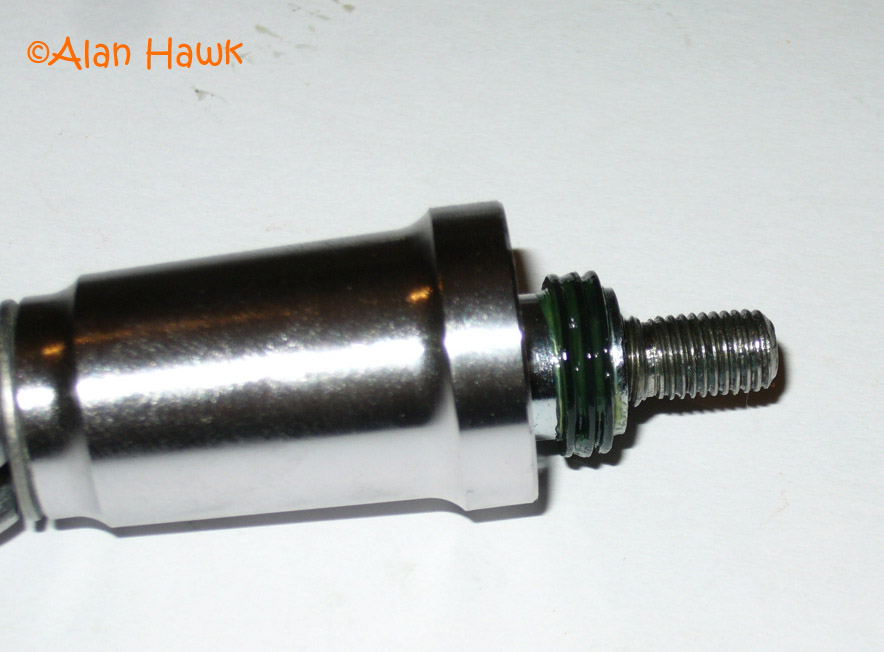 This is the definition of "stupid"! Where the handle screws into the reel there is a seal. Not a single or a double, but a scary TRIPLE seal that belongs to a bloody submarine, not a reel that is marginally resistant to water splashes!! With three separate lips this seal produces a lot of drag and makes the handle almost as tight to rotate as a Van Staal. You can either get a pair of very fine scissors and trim down two lips of the seal and leave one, or rip the entire seal off altogether. I will try the shaving once I get my hands on a proper sharp tool. Otherwise if you want to leave the seal intact, make sure you always keep it well lubricated to reduce its strong gripping effect.
 Finally, in order to change the winding from left to right, you have to unscrew these two caps, one solid and one open, then screw each to the opposite side. These caps are made of plastic, which makes the friction against the triple seal even worse. An extra pair of solid caps come with the reel in the little plastic bag just in case the owner was clumsy enough to lose it, not once, but twice!
The reel's most prominent claim is that it produces 30KG (66lb) of drag pressure. Well, the actual maximum it produced in factory state was about 25.5KG (56lb), and after I lubed the drag washers the maximum drag dropped to 24KG (53lb). These figures are meaningless though, since as I mentioned before the maximum pressure the spool can produce means nothing if the reel as a whole can't handle it in its most vulnerable state.
When I examined the reel out of box I noticed that it uses the exact same body as the old Taurus. The Taurus was rated at 10KG (22lb) of maximum drag pressure, so should I expect the same body to handle three times as much stress as it was originally designed for? I decided to test on stages and see where the limit is, and took a lot of measurements for future reference. The first stage was to fish it and never exceed 10KG (22lb) of drag, which went well except for the stickiness described earlier. Then I examined it thoroughly inside out before moving up to another stage where the maximum drag used stops at 15KG (33lb). Caught a few AJs and the reel handled them flawlessly. Another thorough check then on to a third stage of drag settings higher than 15KG. By then I was fishing off the shores of Oman and nothing big enough was taking artificials within our range. So I changed up to bait and rigged dead Bonito and hoped that maybe I'll get to test it on a shark. First day near dark I got the first bite good enough to actually trigger the drag. I fought it for 10-15 minutes and the spool was heating up more than it should, then the reel froze solid and before I could figure out what's up the fish made a powerful run and the line went limp. I quickly diagnosed the problem as the anti-reverse jamming and clamping down on the pinion, and the only thing I could do to fix it was to forcefully turn the rotor till I freed it. The reel worked as if nothing had happened, and I measured the drag pressure at which that happened and it was about 17KG (37.5lb) give or take half a kilo. Two days later, I went back to that wreck and did the exact same thing, and got another bite that seemed pretty identical to the previous one. I was pretty sure it's a grouper because medium groupers were all we took earlier. Without too much boring details, the anti-revesre seized and froze the reel again, limp line, and this time the FG connection was the casualty and I lost the expensive Seaguar fluorocarbon leader.
Upon examining the reel I found two problems that were not there when the reel was kept below 15KG (33lb) of drag. The rotor's flange was 2-3 mm closer to the tip of the reel's seat, indicating that the reel's stem bent inwards, and inside, the small ball bearing at the bottom of the traverse cam did not spin anymore. In order for me to figure out the damage to that tiny bearing I would have needed to rip it out of the traverse cam, and because it would have been impossible to put it back, I decided to leave it alone. The minute bending in the stem is not something you can notice in a photo, but the effects of the broken bearing could be seen in this photo
 The red arrows point to the rail which that little bearing is supposed to roll on. But since the bearing broke and no more spins, it began rubbing against the rail instead of rolling on it, leading to that surface damage of the finish on the rail.
So, to recap all the above, the Talisman is a low cost reel that in places shows less-than-impressive tolerances and manufacturing imprecision. Examples of that are the undersized drag seal, the partial lack of finish on the black gear driving the oscillation, and the unusual amount of play in the shaft when pushed in and out of the reel's body. But in the mean time it has a gearbox that is virtually indestructible with even the worm gear made of stainless steel, it functions very reliably, and the handle grip is a joy to use all day long. It just happens to be advertised as a competition to tough and proven super-spinners, and with claims of a much higher drag rating than it can actually handle, which creates a false aura of failure around it. If you keep in mind that it's no Stella or Saltiga and fish it at no more than 15KG (33lb) of maximum drag, which is too high for most anglers to handle standing up anyway, it will impress you greatly and will become a favourite workhorse for anything pelagic short of large BFT and similar hard fighting monsters. Fishing is not just about giants, I caught tens of fish on it in the 10-25lb weight bracket and I enjoyed every moment of it. Here are a couple of the smaller fish I caught, yet they provided me with minutes of great sport
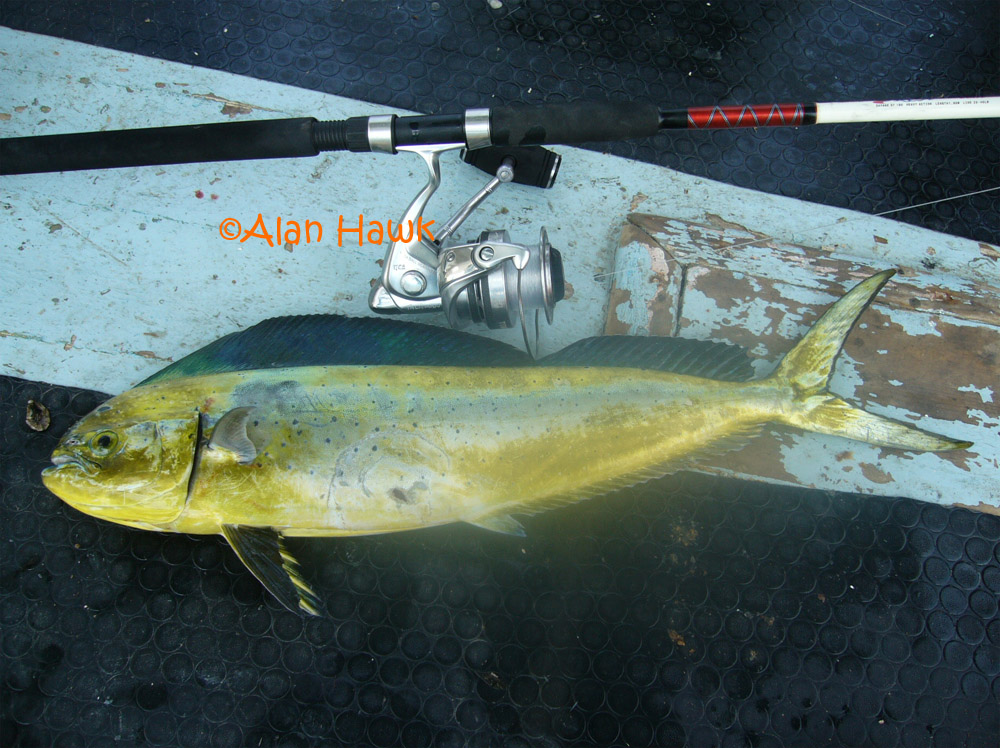 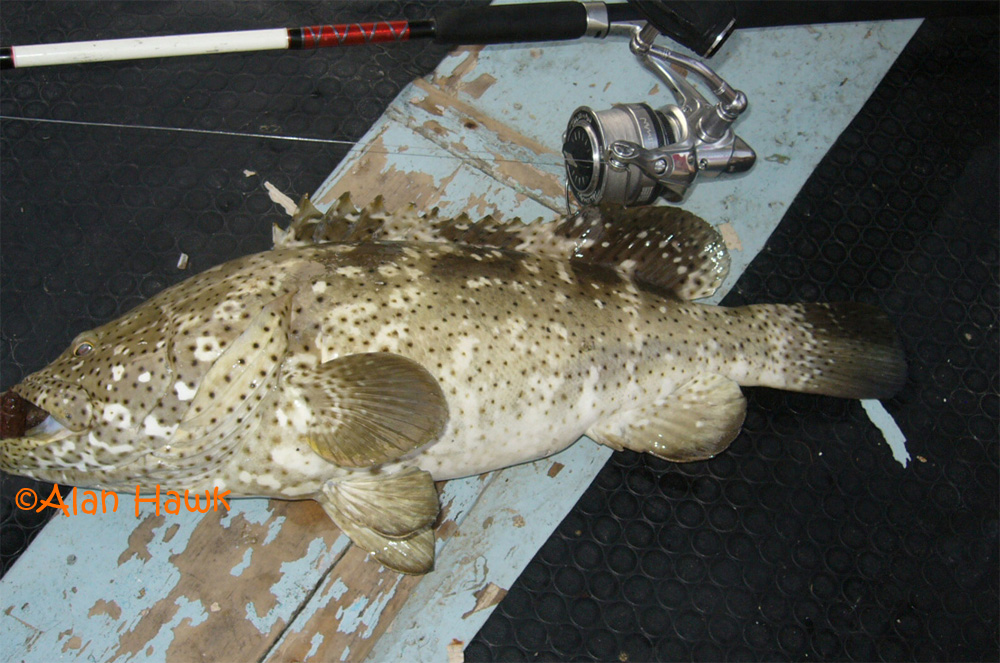 Tica has always been a polarizing brand. People would either call them garbage or tell you how much they love them. It's not always easy to get spare parts for them and Tica's service network is not as extensive as mainstream brands, yet their extremely low prices make up for that and keep their fans loyal. If you ask me to describe the Talisman in one sentence, I would say "maximum value". The $190 I paid for it is $10 short of what I pay for 90 minutes of sports massage, and much less than just the customs duty I paid when I bought my latest Stella!
I hope you've enjoyed this and feel free to go to the contact page and send me any questions or tell me which reel you want to see reviewed in the future.
Cheers
Was this a good read? Please click here
Alan Hawk
November, 10th, 2011
|